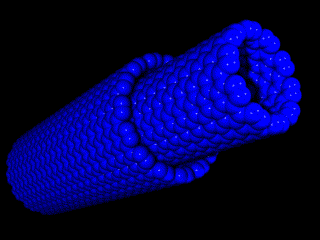
Zettl Research Group |
Research Project |

Micro-Electromechanical Systems (MEMS) consist
of mechanical devices made with traditional semiconductor processing
techniques. MEMS are used for applications as varied as airbag deployment
sensors, RF components, "lab on a chip" devices for DNA analysis, and
bio-chemical sensors. As these devices get smaller, their beneficial
properties increase: with a decrease in device size, the sensitivity of sensors,
the frequency of oscillators, and the packing density of devices are all
increased. Silicon processing has its limits, however, and we are soon
forced to look for other avenues to approach the fabrication of Nanoscale
Electromechanical Systems, NEMS.
Nanotubes present themselves as an ideal material to be used in NEMS devices for a number of reasons. As oscillators they should have extremely high resonance frequencies (in the Gigahertz) and very high quality factors due to their size and mechanical strength. The atomically perfect, nested layer structure of multi-walled carbon nanotubes suggests that they could be used as linear and rotational bearings. Their ability to flex over large angles without breaking suggests that they could also be used for mechanical switches and as hinges. We have developed nanoscale devices that aim to take advantage of the perfect graphitic structure of carbon nanotubes.
Our group has developed nanoscale linear bearings from multiwall carbon nanotubes, in which the inner core slides independently of the outer walls. The devices show wear-free motion, and the inner core automatically retracts when released due to van der Walls interaction between nanotube shells. This work was done in situ in a transmission electron microscope (TEM) using a nanomanipulation stage constructed by our group.
We have also recently developed rotational bearings based upon multiwall carbon nanotubes. By attaching a gold plate (with dimensions of order 100nm) to the outer shell of a suspended multiwall carbon nanotube, we are able to electrostatically rotate the outer shell relative to the inner core. These bearings are very robust; we have oscillated devices thousands of times with no indication of wear. This work was done in situ in an SEM. A copy of the original paper can be found here, supplementary information is available here.
Using these rotational bearings we are able to measure interesting properties of multiwall carbon nanotubes, including their interlayer friction coefficient and their torsional modulus. We plan further studies into suspended nanotube devices, including torsional oscillators and oscillating doubly-clamped beam experiments.
Together, the devices described
above form the fundamental
building blocks for more complex nanoscale machinery. Starting from
simpler (and yet very useful) systems such as switches, sensors, and actuators,
we hope to create nanoscale instruments with far-reaching applications in industry,
medicine, and the physical sciences.